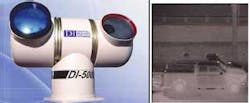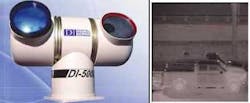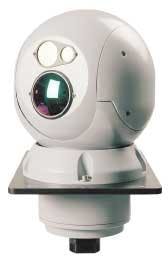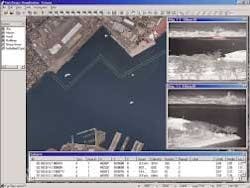Thermal imaging spots terrorist threats
Various infrared and thermal-imaging devices help detect covert threats, objects, and suspects.
By R. Winn Hardin, Contributing Editor
Unlike standard image intensifiers that amplify low levels of visible light, thermal imagers are sensitive to infrared (IR) light and are not susceptible to "blooming," a condition caused when a bright-light source relative to the surrounding environment is directed at the intensifier, temporarily blinding it. Therefore, industries and government agencies expect to expand their use of thermal imagers in perimeter and threat detection, response to threat conditions, object and package inspection, and deception detection.
Most people think of fences, barbed wire, and guards when they think about physical security. However, fences and wire merely slow someone down, while human patrols are costly and susceptible to fatigue and boredom. A better solution is a network of cameras that can be monitored from a single location and are supported by software that will help automatically identify potential threats.
Night vision
"At night, particularly, closed-circuit television (CCTV) has a range of about 100 ft, not including obstructions such as fog or trees," says Chris Bade, president of Raytheon Commercial Infrared (Dallas, TX, USA). "Even though it costs $300 to $500 per camera, if you translate to price per foot it comes out to $5 per foot.
High-performance thermal cameras cost about $25,000 and can view distances to half a mile under most conditions—about $8 per foot. The Raytheon amorphous-silicon microbolometer is a drop-in replacement for CCTV, says Bade. It is about the same size and shape, has the same input and output ports as CCTV, and fits into an enclosure at a price of $6500 to $7000. With a 1000-ft range, the cost per foot is $6.50. Other options, such as low-light image-intensification cameras, do not work adequately during daylight.
Although Raytheon is the sole provider of barium strontium titanate ferroelectric sensors, other sensor options and providers of low-cost IR imaging systems are available. For example, FLIR Systems (Portland, OR, USA) uses microbolometer technology for short-range applications, approximately 500 to 1500 m, and indium antinomide and quantum-well-infrared-photodetector technology that ranges from a few kilometers for hand-held systems to 15 km for pole-mounted systems.
"Range performance is determined by optics," says Andrew Teich, FLIR senior vice president of sales and marketing. "Most long-range systems offer three different fields of view, operating mainly in wide and medium fields of view for detection purposes and switching to narrow fields of view for identification when an analysis package or person sees something."
High-end systems such as the DI-5000 from Digital Imaging Infrared (DII; Apopka, FL, USA) can overlay IR images onto visible images in cases where objects or suspects are hiding behind obstacles that cannot be penetrated by visible light, such as a tree, smoke, or fog. The system camera comes equipped with multiple sensors, making it sensitive in two spectral regions, 8 to 12 µm long-wavelength IR (thermal) and 425 to 700 nm (visible). These two regions give the camera and the user vision under most weather conditions, day or night.
The system can display either the IR or visible image separately or can provide a fused real-time image using analog fusion (see Fig. 1). The standard version has a 50-mm–f/0.8 lens for the IR, which gives a 14° × 18° field of view. The IR camera has a 2X or 4X electronic zoom. The visible camera has a zoom lens to 22X and also a 10X digital zoom. A laser rangefinder uses an eye-safe diode laser with a range between 20 and 1500 m and is integrated into the system with the range information annotated on the display.
FLIR Systems also has adopted its long-range systems to commercial airborne and sea operations. For example, the SeaFLIR system incorporates gyrostabilization, compensating for ship movement to enable long-range viewing and auto-image analysis for threat detection (see Fig. 2).
The company also offers airborne systems that can be installed on either fixed-wing aircraft or helicopters. These gimbal-based systems are gyrostabilized and typically hold several payloads, including the IR imager, standard video camera, long-range optical scope, laser rangefinder, and laser pointer or illuminator. Law-enforcement personnel or emergency medical technicians work with the laser pointer on the ground using night-vision goggles. A helicopter can locate a criminal or someone that is injured and using the laser pointer direct the ground personnel to the individual without the individual knowing that they are being illuminated.
Several manufacturers are also investigating directional IR countermeasures for commercial airlines, similar to those supplied to military aircraft. These systems use IR imagers to detect shoulder-fired missiles and other bright threats and then direct an intense laser beam at the incoming warhead, temporarily blinding the missile's guidance system.
Complete perimeter
The majority of homeland-security applications will involve ground-based systems. For example, the US Naval Shipyard in San Diego, CA, has a security system that uses software from VistaScape Security Systems (Atlanta, GA, USA; see Fig. 3). "We had a process that was manpower-intensive," says VistaScape president and chief executive officer Glenn McGonnigle. "We had people on patrol boats providing detection and security for naval ships at port. With a VistaScape Security Data Management System (SDMS) in place and approximately 50 cameras—most of them thermal—the Navy can provide perimeter security on land and water with one person at one monitor."
As part of the SMDS, data from 34 DII cameras are processed locally into event records, encrypted, and transmitted to a central location. Data are then fused into a single data model, analyzed, and archived into a database. The data are displayed on a virtual 3-D model of the area under surveillance. Most IR cameras are DI-9800, fixed 320 × 240 uncooled microbolometer cameras. Others are DII DI-5000 pan-and-tilt cameras, which make use of uncooled microbolometers and a visible color TV camera (whose image can be fused with the infrared image) and laser rangefinder.
The SDMS builds on concepts similar to those of the US Defense Advanced Research Agency video surveillance and monitoring technology, which uses image- processing libraries to detect changes in streaming video and identify and categorize potential threats based on shape, IR intensity, and other issues. Software compares the identified threat with camera location and stored digital schematics or aerial photos to display the "real" location of the threat in the context of the facility, making the system more intuitive to operators that may not have extensive computer or software training.
Emerging applications
Indigo Systems (Santa Barbara, CA, USA) has worked with other IR applications. According to Roy Malmberg, Indigo security and surveillance segment manager, short-wavelength IR cameras can effectively see through some paints and other materials that terrorists might use to obscure cargo-shipping container markings or the markings on a vessel or airplane (see cover). "Infrared information is usually collected from the first few microns of the material's surface," he says.
"Different paints have different emission characteristics, allowing you to see through to the underlying obscured materials. The near-IR cameras use InGaAs detectors sensitive from 900 to 1700 nm and can sort through the emission characteristics of different paints," adds Malmberg.
In another application, Malmberg has worked closely with researchers at the Mayo Clinic (Rochester, MN, USA), Honeywell Laboratories (Morris Township, NJ, USA), and University of Houston (Houston, TX, USA) who have used sensitive, cooled IR cameras to detect when a person is telling the truth. According to the researchers, sensitive IR cameras can detect temperature increases around the eyes and in certain areas of the face that indicate deceit.
Currently, the IR-imaging market stands on the cusp of significant growth as homeland-security funds begin to trickle down to specific projects. "IR is a priority item today," says Raytheon's Bade. "The federal budget and supplemental war budget will really focus the money down to the state and local levels. There has not been a lot of money out there yet, but there are a lot of requests for purchases, and the activity is likely to grow."
This article is excerpted from "Thermal imaging: a hammer in the counterterrorism toolbox," Homeland Security Solutions, June 2003, p. 18; www.homelandsecuritysolutions.com.
Company Info
Digital Imaging Infrared www.dii-llc.com
FLIR Systems www.flir.com
Honeywell Laboratories www.honeywell.com/honlab/tech.html
Indigo Systems www.indigosystems.com
Mayo Clinic www.mayo.edu
Raytheon Commercial Infrared www.raytheoninfrared.com
University of Houston www.uh.edu
VistaScape Security Systems www.vistascape.com



